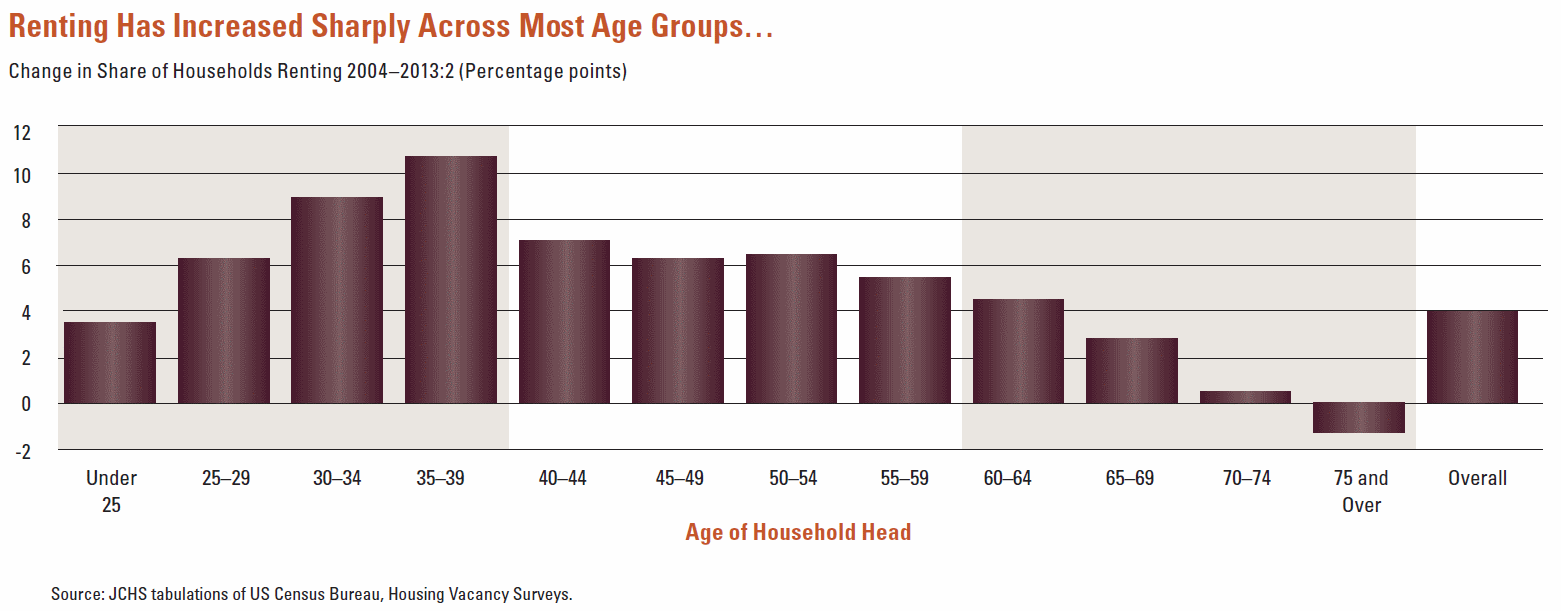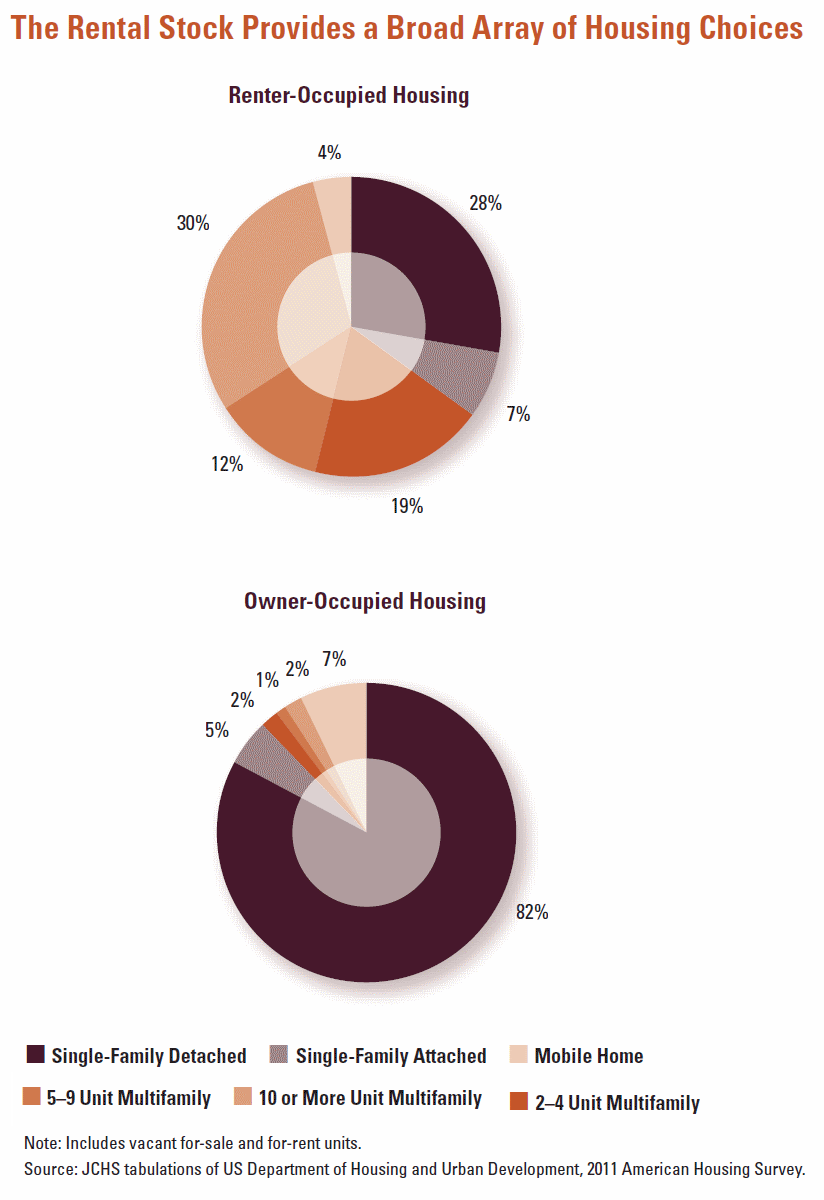A new study from the Harvard Joint Center on Housing Studies in conjunction with the McArthur Foundation looks at the growing importance of rental housing in the U.S. as households reverse their long upward trend in homeownership and increasingly turn to renting. The renter share of households climbed from 31 percent in 2003 to 35 percent in 2013 or 43 million households.
The study, America's Rental Housing: Evolving Markets and Needs, looks at the factors contributing to the growing reliance on rentals, how likely the trend is to continue and the human and policy impacts of the trend. Of particular importance, the study concludes, is the crisis presented to the country by the growing burden housing is placing on low and very low income households.
The trend toward renting has been driven by several factors. The Great Recession brought high levels of sustained unemployment and a flood of foreclosures while highlighting some of the risks of homeownership and the benefits of renting; greater ease of moving, the ability to better budget for housing, and freedom from maintenance responsibilities.
The shift toward renting has affected all but the oldest age groups with most cohorts exceeding the overall 4 percent increase. Only high homeownership rates among the oldest age groups moderated the increase which made the 2000s the strongest decade of growth in renter households in half a century.

The Center expects this growth to continue, but not at the current pace. Depending on the trajectory of immigration, they project renter household to increase by 4.0 to 4.7 million over the next ten years. While this would represent a considerable slowdown from the current rate, it would still outstrip growth in both the 1960s and 1990s.
Mirroring overall population growth, minorities will contribute virtually all of the net increase in renters over the coming decade, with Hispanics alone accounting for more than half of the total. Significant shares of the younger renter households will be married couples with children and single-parent families, which together will account for another 30 percent of new renters. This group of households will seek more spacious homes to accommodate their larger families and in locations with access to good schools and employment opportunities. The rapid increase in the senior population will lead to their higher numbers of renters. This population will require some level of adaptive housing to accommodate them as well as assisted living.
While renting is more common among young adults, more than a third of renters are aged 35 to 54, about the same as their population share. Even at stages when homeownership is greatest people still move in and out of the rental market. Against stereotype, families with children account for as many renters as single persons. Renters' incomes are disproportionately low. Nearly a quarter have annual incomes under $15,000 while only 13 percent of all households fall into that category. 2
Unlike owner-occupied housing, rentals come in a variety of configurations. About four out of ten properties are single-family homes, another fifth are in two to four unit buildings and 30 percent are in buildings with 10 or more units. Rental housing is more likely to be located in urban areas and tends to concentrate in low-income communities.

Much of the demand from the recent increase in renter households was met by the 3.0 million units, mostly single family, that changed from owner occupied to rental property between 2007 and 2011, pushing the share of single-family rentals up 4 percentage points, to 35 percent, in 2011. Institutional investors also began buying up single-family properties for rentals, testing new business models that may further expand rental housing options.
Rental housing has bounced back from the Great Recession faster than the rest of housing. Demand forced down vacancy rates and led to rent increases and increases in landlord operating income and property values. Multi-family housing starts jumped 54 percent in 2011 and the improvement has been wide spread across markets.
The study says one aspect of the rental market that does bear watching is multifamily finance. Credit sources dried up there as elsewhere during the downturn with activity sustained through government channels.
The situation for renters who were cost burdened before the recession worsened during and after it. After 2007 the share of renters paying more than 30 percent of their income for housing rose from 38 to 50 percent. Most of the increase was felt by those severely burdened, i.e. paying more than 50 percent of their income for housing by 2010.
Housing cost burdens are nearly ubiquitous among the lowest-income renters. "An astounding 83 percent of renters with incomes of less than $15,000 were housing cost burdened in 2011, including a dismal 71 percent with severe burdens. But the largest increases in shares in 2001-11 were for moderate- income renters, up 11 percentage points among those with incomes of $30,000-44,999 and 9 percentage points among those with incomes of $45,000-74,999," the study says.
Unemployment accounted for some of the increase in housing burden but it has been even worse among households with full-time workers where the cost-burdened share of renters rose by nearly 10 percentage points or by 2.5 million between 2001 and 2011.
The consequences for those unable to find affordable housing the Center says is dire. They spend about $130 less on food, 40 percent less than those living in housing they can afford. Thus housing is clearly linked to hunger in the U.S. They also spend significantly less on health care and retirement savings.
A family with a $15,000 in annual income would have to find housing that costs no more than $375 a month to stay under the 30 percent level. By comparison, the 2011 median monthly cost for housing built within the previous four years was more than $1,000. Less than 34 percent of these new units rented under $800, and only 5 percent for less than $400."
Thus the gap between the demand for and the supply of affordable units continues to grow. In 2011, 11.8 million renters with extremely low income competed for just 6.9 million rentals affordable at that income level. Making matters worse, 2.6 million of these affordable rentals were occupied by higher-income households. The study also evaluates energy costs and concludes that these costs also fall disproportionately on low income renters, either directly or as pass-throughs from land lords.
Housing that is affordable to low income renters tends to be older and more likely to be in poor condition and so at greatest risk of being demolished or otherwise lost from the housing stock. Over the 10 years ending in 2011, 5.6 percent of all units available for rent were removed from the inventory as were 12.8 percent of those renting for those renting for less than $400.
Rental subsidies are also reaching fewer very low income households. Between 2007 and 2011 the number of such renters increased by 3.3 million while the number able to receive subsidies expanded by only 225,000 and the share of eligible households receiving assistance shrunk from 27.4 percent to 23.8 percent. The number of renters with worse case needs receiving no assistance jumped by 2.6 million to 8.5 million.
Even where funding for assistance increased, rising rents and falling incomes raised cost and limited the reach to more households. About $26 million in capital investments for public housing remains unfunded and privately owned housing is rapidly aging and assistance contracts are expiring. Mandatory budget cuts under sequestration could reduce vouchers by 125,000 this year.
So far, the Low Income Housing Tax Credit (LIHTC) program has been spared from sequestration but its subsidies are inadequate to make units affordable for extremely low-income tenants, so it is often combined with other forms of assistance. The program may be endangered when debate about tax reform begins in earnest.
The study looks at the two factors which it says will influence rental growth over the next decades; the growth of households and prevailing attitudes toward homeownership. While economists can give some estimates of the first, the second is subject to so many influences it is nearly impossible to predict.
The study points to other issues that can impact rental housing going forward; the aging housing stock, barriers to construction, and the looming reform of the government related sources which currently provide most of the financing for rental units.
The study concludes that, despite the magnitude of the affordability crisis and the clear need for new thinking about assistance, active debate on rental housing policy has just begun. There are promising approaches from both government and advocates, but as the country faces difficult choices and an aging population and rising health care costs strain the federal budget, it would be all too easy for rental housing concerns to get lost in the debate.







